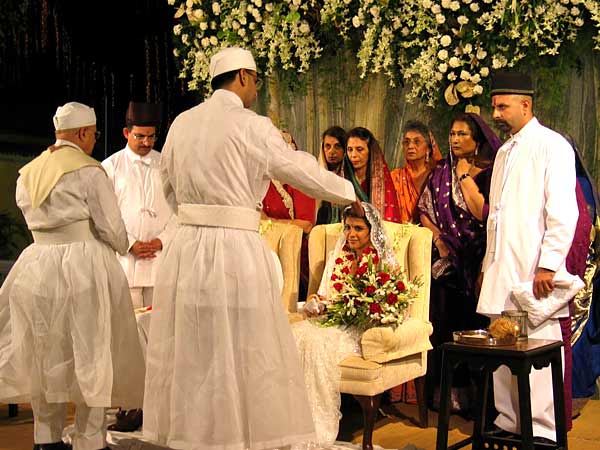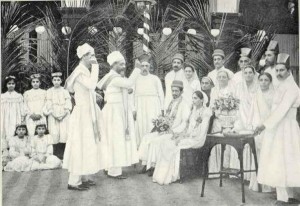Parsis Marriage Ceremony
Parsis Marriage
Parsis Wedding traditions and rituals are quite different from Hindu marriages. The following patterns are fascinating and make full enthusiasm. The ways during the Parsi wedding are pretty simple, and all the Parsi people get full enjoyment during the wedding ceremony. The Parsi marriage extended beyond one week. The one-week rituals are divided into Pre-wedding, marriage day and Post-wedding ceremonies. Every day, special celebrations are conducted between the newly wedded couples and among the attendees to the marriage.

Dresses of the Marriage couples:
The Bride and the Bridegroom wearing dresses indicate the symbolism of purity in their minds. The bridegroom’s principal ceremonial dress is called the Jama-Pichori or Sayah. The dress is white with a loose flowing, full of folds and curls. The Bride’s sariBridelso loose clothing full of folds and curls. The bridegroom wears a white gown and holds in his hand a shawl. It is the symbol of respect and greatness in India. They have marked the kumkum on their foreheads. The marked Kunkum on the forehead of the bridegroom is long and vertical and round in shape to the BrideBride’shead. The brideBridebridegroom hangs the flower garlands to their necks.
Parsis Wedding arrangements:
Like Hindu marriages, the bridegroom sits in the room where the wedding is celebrated after the bride brides and centre on the right-hand side of the bridegroom. There are two trays of rice kept beside both. And a small metallic pot containing ghee was held beside the brideBride burning candles on each side of the brideBridebridegroom. During the marriage ceremony, the brideBridebridegroom has each a marriage witness. They should be married and close relatives of the couple.
Parsis Wedding The following Rituals:
The first bridegroom sits in the room of the marriage place. Then the brideBrideves and sit opposite him, and both are separated by a piece of cloth held between them by two persons. Keeping the curtain makes the brideBridebridegroom may not see each other. Then the priest united their hands as soon as the curtain was held over the hands. The hand fasting ceremony completed the curtain removed, and they are made to sit side by side. This is the significance that those separated up to then are now united. Then the priests pass around the brideBridebridegroom and enclose them with a circle of a white piece of cloth. After some chanting, the ends of the fabric are tied together. Finally, brideBridethe scared knot. After the fearful event, all the elders blessed the new couple. The priests conduct among them some games like each other throwing the rice on their heads and picking up the rings from the drip and some others.

The two priests stand before the married couple. The senior priest is before the bridegroom, and another before the brideBriden, the old priest, reads the recipes in Pazand. They are:
“May the Creator, the Omniscient Lord, grant you a progeny of sons and grandsons, plenty of means of provision, heart-ravishing friendship, bodily strength, long life and an existence of 150 years”.
Asking Questions by Priests:
The senior priest asks questions to witnesses on both sides.
“In the presence of this assembly that has met together in [here the name of the city where marriage takes place is mentioned] on [name the day] day [name the month] month of the year[name the year] of Emperor Yazdegard of the Sasanian dynasty of blessed Iran, say, whether you have agreed to take this maiden, [name the bride] by name, in marriage for this bridegroom, by the rites and rules of the Mazdayasnians, promising to pay her 2,000 dirams of pure white silver and two dinars of real gold of Nishapore coinage.”
The witness recipes: I have agreed.
Then another question to another witness on the side of the Bride:
‘Have you and your family, with righteous mind and honest thoughts, words, actions increase of righteousness, agreed to give, forever, this brideBridearriage to[name the bridegroom]?
The witness replies: I have agreed.
Now the questions to the couple.
‘Have you preferred to enter into this marriage contract up to the end of your life with a righteous mind”?
The couple replied at once ‘I have preferred.”
This same question asks three times, and these three times, the couple answers the same.
Final rituals:
After completing all the principal rituals, the priests address the new couple with Admonitions, Prayers and Benedictions.
Admonitions: The priest advises the couple about their behaviour in life.
Prayers: The priests pray to God to bless the couple.
Benedictions: The priests wish the couple may be blessed with virtue.
By completing all these rituals, the marriage ceremony ends.